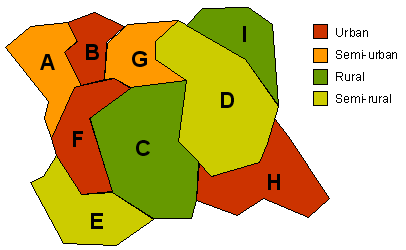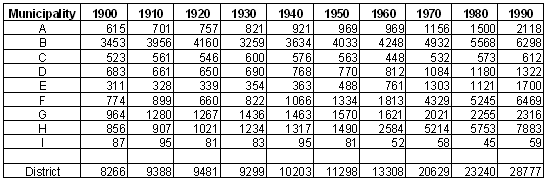|
|
Thematic Change Analysis
How can thematic changes of spatial features be
analysed?
According to the wide diversity of contexts
presented there are numerous potential methods for
this task. Objectives of such analysis concentrate on the change of thematic
properties of observations – in our case spatial features - regardless of their
spatial nature and distribution. Of course these methods can pretend to belong
to the toolbox of spatial analysts. However they need companion methods applied
in a further stage of analysis to fulfil the task of spatial analysis: the
spatial distribution analysis of these thematic changes. These companion methods
will be presented in the Unit 3: Spatial change analysis.
The following criteria defining the context of analysis are
considered:
- Time description: 2 limits or discrete intervals
- Level of measurement: qualitative or quantitative
- Single or multiple observations analysis
- Uni or Multi-variate analysis
The presentation of thematic change analysis methods is organised into 3
groups of methods:
-Production of change indices: univariate description of a set of multiple observations
-Time series behaviour description:
univariate description for individual behaviour of
observations
-Multivariate methods: multivariate
description of a set of multiple observations.
Let’s take a common example to illustrate thematic change analysis discussed in this Lesson. The study area is composed of 9 spatial features corresponding to the municipalities of a district. Several phenomena were measured during a period of time ranging from 1900 to 1990.
Variables expressing their properties at each decade during this period of time are the following:
-Number of inhabitant (population): quantitative data at cardinal level
-Political majority: qualitative data at nominal level
-Number of wired telephone subscription: quantitative data at cardinal level
-Gender of the municipality mayor: qualitative data (binary) at nominal level
 The 9 municipalities constituting the district under study
The 9 municipalities constituting the district under study Number of inhabitant at each decade during the period 1900 to 1990
Number of inhabitant at each decade during the period 1900 to 1990Learning Objectives
- You will be able to select appropriate methods and techniques for a specific context of thematic change analysis
- You will master the basic principles of various thematic change methods and be able to access to related text references for in depth learning
